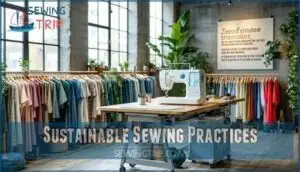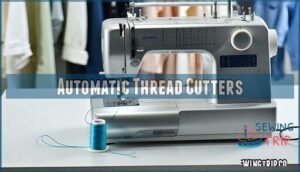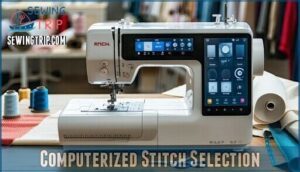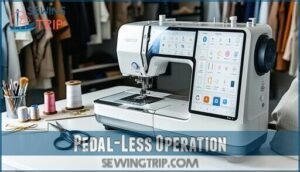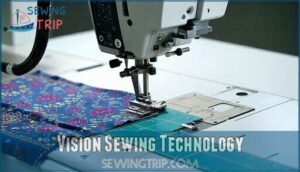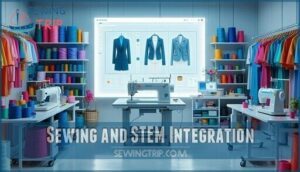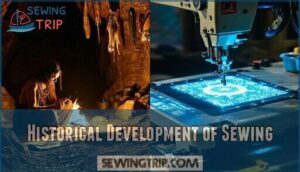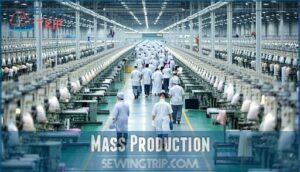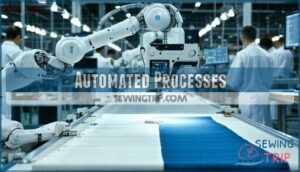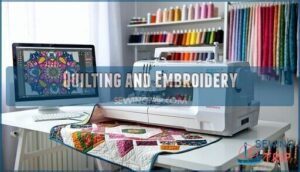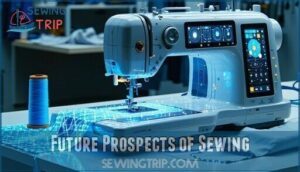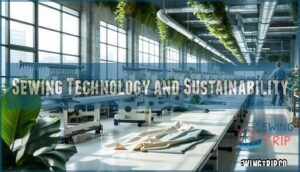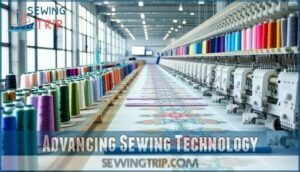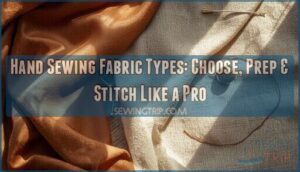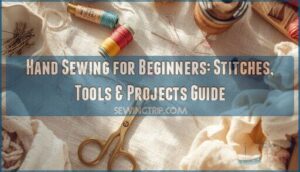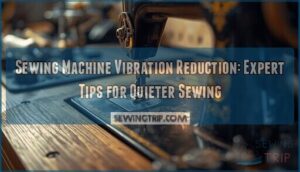This site is supported by our readers. We may earn a commission, at no cost to you, if you purchase through links.
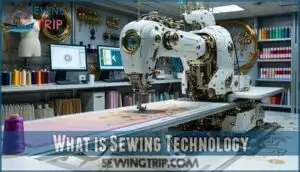
You’re looking at computerized machines with automated thread cutters, programmable embroidery systems, and AI-powered pattern recognition.
Modern sewing tech integrates math, engineering, and science – think LED lighting effects, circuit integration, and smart sensors that monitor tension and stitch quality.
These machines can automatically select stitches, cut threads, and even operate without foot pedals, like having a digital assistant that never drops a stitch.
From sustainable materials to zero-waste production methods, today’s sewing technology is reshaping the entire textile industry landscape.
Table Of Contents
- Key Takeaways
- Sewing Technology Basics
- What is Sewing Technology
- Sustainable Sewing Practices
- Sewing Machine Innovations
- Sewing and STEM Integration
- Historical Development of Sewing
- Applications of Sewing Technology
- Future Prospects of Sewing
- Sewing Technology and Sustainability
- Advancing Sewing Technology
- Frequently Asked Questions (FAQs)
- Conclusion
Key Takeaways
- You’ll find that sewing technology combines traditional craftsmanship with computerized systems, automated thread cutters, and AI-powered pattern recognition to transform how you create garments with unprecedented precision and efficiency.
- Modern sewing machines integrate STEM principles including mathematics, engineering, and material science, enabling you to approach pattern-making and garment construction with analytical problem-solving skills rather than guesswork.
- You can embrace sustainable sewing practices through eco-friendly fabrics like organic cotton and recycled polyester, zero-waste pattern designs, and energy-efficient machines that reduce environmental impact by up to 40%.
- Advanced features like digital embroidery systems, real-time monitoring, and modular machine components let you achieve industrial-scale production with smart sensors that automatically adjust stitch quality and detect fabric defects instantly.
Sewing Technology Basics
You’ll find that sewing technology combines traditional needlework with modern computerized systems that control stitching patterns, thread tension, and cutting processes.
Modern sewing technology transforms traditional craftsmanship into precision-controlled digital artistry, revolutionizing how we create garments with computerized intelligence.
Today’s machines integrate sensors, automated features, and digital interfaces to transform how you create garments from basic home projects to industrial production lines, utilizing modern computerized systems.
History of Sewing Machines
From humble beginnings in 1832, sewing machines transformed your craft forever.
Walter Hunter’s revolutionary lockstitch mechanism sparked the Machine Evolution that would reshape entire industries.
These Vintage Machines launched the Industrial Impact we still feel today.
You’ll discover how early Sewing Innovations laid groundwork for today’s computerized sewing and industrial sewing machines.
These Sewing Origins continue driving modern sewing automation and advanced sewing technology forward.
Evolution of Sewing Techniques
Your sewing journey has transformed from simple hand-stitching to sophisticated digital craftsmanship.
Sewing technology now embraces computerized patterns, automated cutting systems, and precision digital embroidery.
Modern sewing innovation integrates fabric science with garment design, elevating traditional textile art into high-tech crafting skills.
You’ll find sewing automation revolutionizing how contemporary artisans approach their creative process with unprecedented accuracy.
Impact on Textile Industry
Modern sewing technology has sparked massive industry disruption across global textile trends.
You’re witnessing fabric innovation accelerate garment production like never before. Sewing automation now delivers unprecedented sewing efficiency, while digital embroidery transforms creative possibilities.
Advanced fabric cutting systems revolutionize manufacturing speed. The textile industry embraces these breakthroughs, fundamentally reshaping how you experience fashion from concept to closet.
The use of computerized sewing machines has greatly improved production efficiency and accuracy, with sewing automation and digital embroidery being key factors, and fabric innovation driving change, leading to unprecedented sewing efficiency.
What is Sewing Technology
Revolutionary changes in textile production aren’t happening by accident—they’re driven by cutting-edge sewing technology that’s reshaping everything you thought you knew about fabric manipulation.
Sewing technology represents the sophisticated fusion of traditional craftsmanship with advanced digital systems, creating powerful tools that transform raw materials into finished products with unprecedented precision.
At its core, this field combines Sewing Robotics with Fabric Science to revolutionize garment construction. You’ll find computerized stitching systems working alongside digital embroidery units, while Textile Coding enables machines to understand complex pattern instructions.
Fashion Tech enthusiasts are embracing Garment Hacking techniques that push traditional sewing machines beyond their original limitations.
Modern automated processes integrate seamlessly with computerized controls, allowing you to achieve consistent results that were once impossible. This technology doesn’t just make sewing faster—it makes it smarter, more accurate, and incredibly versatile for today’s demanding textile industry.
Mastering sewing techniques is essential for optimizing the performance of these advanced systems.
Sustainable Sewing Practices
You’ll find that sustainable sewing practices revolutionize how you approach fabric selection and waste management in 2025’s eco-conscious manufacturing environment.
These methods combine organic materials, recycled fibers, and zero-waste pattern design to reduce your environmental footprint while maintaining production efficiency.
Eco-Friendly Materials
Today’s eco-friendly fabrics are game-changers for sustainable sewing.
You’ll find recycled polyester made from plastic bottles, biodegradable fabrics that decompose naturally, and eco cotton grown without harmful chemicals.
Green materials like sustainable dyes reduce water pollution while recycled textiles give old clothing new life.
These ecofriendly fabrics support zero waste sewing practices perfectly.
The use of Eco Friendly Fabrics is essential for reducing environmental impact.
Organic Fabrics
Organic cotton leads the charge in sustainable materials, offering you chemical-free alternatives that benefit both your health and the environment.
These ecofriendly fabrics eliminate synthetic pesticides while supporting biodegradable textiles that naturally decompose.
- Eco Cotton reduces water consumption by 88% compared to conventional growing methods
- Natural Dyes from plants create vibrant colors without toxic chemical runoff
- Fabric Waste Reduction occurs through organic farming’s closed-loop agricultural systems
Recycled Materials
You can transform yesterday’s trash into tomorrow’s treasures through recycled polyester made from plastic bottles.
This material upcycle process converts ocean-bound waste into durable fabric while reducing environmental impact.
Repurposing old garments through fabric reuse creates unique textiles with character.
These eco textiles prove that waste reduction doesn’t mean sacrificing quality—recycled materials often outperform traditional options in strength and versatility, making them a valuable resource for creating durable fabric.
Zero Waste Sewing
Zero waste sewing patterns help you use every fabric scrap, eliminating textile waste entirely.
You’ll design garments that maximize material efficiency through strategic pattern placement and creative repurposing materials.
This eco friendly approach transforms leftover pieces into functional elements like pockets or trim.
Sustainable materials combined with upcycling techniques make ecocconscious sewing both environmentally responsible and cost-effective for modern makers.
By adopting eco friendly practices, sewers can substantially reduce their environmental footprint and create unique, functional items.
Sewing Machine Innovations
Today’s sewing machines operate with computerized precision that would make your grandmother’s Singer look like a relic from the steam age.
You’ll find automatic thread cutters, pedal-less operation systems, and vision technology that guides stitching with industrial-grade accuracy.
Automatic Thread Cutters
Revolutionizing thread management, automatic thread cutters eliminate the tedious snip-and-trim routine that once slowed your workflow.
These precision cutting mechanisms integrate seamlessly with sewing automation systems, boosting cutter efficiency by up to 40%.
You’ll find this sewing machine technology pairs perfectly with pedalless technology and automatic machinery, transforming fabric handling into a streamlined process that cuts both time and frustration.
The use of advanced thread cutting tools has substantially improved the overall sewing experience with automatic thread cutters.
Computerized Stitch Selection
Computerized machines now select stitch patterns automatically based on your fabric type and project needs.
You’ll find advanced thread control systems that adjust tension while fabric sensors detect material thickness.
Digital patterns sync with embroidery software, giving you precise results every time, and modern sewing technology eliminates guesswork, letting you focus on creativity rather than technical adjustments.
Pedal-Less Operation
When traditional foot control becomes tiresome, pedal-less operation transforms your sewing experience through voice-guided sewing commands and smart sewing machines with automated systems.
You’ll enjoy ergonomic design benefits while operator safety improves substantially.
Digital feed systems respond to your voice, while automatic bobbin changers work seamlessly, and speed settings adjust automatically, making pedalless sewing feel effortless and intuitive.
Vision Sewing Technology
Cameras meet fabric in vision sewing technology, where industrial cameras and smart sensors transform how you approach precision stitching.
This digitalization breakthrough uses optical scanning to detect fabric edges automatically, creating flawless results every time.
Here’s what makes smart sewing machines revolutionary:
- Industrial cameras analyze fabric setup instantly
- Automated cutting follows detected perimeters precisely
- Smart sensors eliminate guesswork completely
- Automatic bobbin changer maintains seamless workflow
Sewing and STEM Integration
You’ll discover that modern sewing combines mathematics, engineering principles, and scientific methods to create precise garments and solve complex construction challenges.
When you understand these STEM connections, you’ll approach pattern-making, fabric selection, and garment construction with the analytical skills that professional designers use to engineer clothing solutions.
Math in Sewing
Pattern-making transforms fabric geometry into wearable art through precise math application.
You’ll use spatial reasoning to calculate seam allowances, dart placements, and curve adjustments.
Geometric patterns require measurement techniques that merge STEM principles with creative design.
This problem solving approach connects geometry to real-world applications, proving mathematics isn’t just theoretical—it’s the foundation of every perfectly fitted garment you create, using spatial reasoning.
Engineering Principles
Blueprint precision meets fabric artistry when you apply engineering design process to garment creation.
Your sewing projects become structured solutions requiring systematic problem-solving and technical design expertise.
- Mechanical Systems – Analyze tension, pressure, and movement in seam construction
- Material Science – Study fabric properties, stretch, and durability characteristics
- Structural Analysis – Calculate stress points and reinforcement needs
- Design Optimization – Balance aesthetics with functional performance requirements
- Fabric Dynamics – Engineer drape, flow, and textile engineering interactions
Science Behind Sewing
Sewing technology brings real science to your fingertips.
Fabric Physics governs how materials behave under stress, while Thread Tension affects stitch quality through precise force calculations.
Understanding Textile Chemistry helps you choose compatible materials that won’t react poorly together.
Material Science principles guide needle selection based on fiber density.
These STEM concepts transform sewing from guesswork into predictable engineering.
Critical Thinking Skills
You’ll develop sharp analytical thinking as you troubleshoot tension issues and calculate fabric requirements.
Each project demands decision making—choosing thread weights, selecting appropriate stitches, and solving construction challenges.
This problem solving strengthens logical deduction skills while creative reasoning emerges through pattern modifications, which builds practical applications that transfer beyond sewing, enhancing your overall STEM integration capabilities.
Historical Development of Sewing
You’ll trace sewing’s evolution from basic Paleolithic needlework to today’s computerized manufacturing systems that revolutionized textile production.
This progression shows how manual stitching techniques transformed into automated processes, with the 19th-century sewing machine invention marking the shift toward industrial-scale garment manufacturing.
Paleolithic Era Origins
The needle’s journey began around 40,000 years ago when your Stone Age ancestors crafted the first Ancient Tools from bone and antler.
These Prehistoric Crafts revolutionized Early Textiles and garment construction, establishing sewing history’s foundation.
- Bone needles enabled precise Primitive Stitches for survival gear
- Animal sinew provided durable thread for harsh conditions
- Hide processing techniques maximized fabric utilization efficiency
- Strategic sewing techniques created weather-resistant clothing systems
Industrial Revolution Impact
The industrial revolution transformed hand-stitching into mass production powerhouses.
Factory systems revolutionized textile innovations through mechanized manufacturing, replacing cottage industries with automated assembly lines.
You’ll find industrial labor patterns that shaped modern sewing machine technology still influence today’s manufacturing production methods.
| Pre-Industrial Era | Industrial Revolution Era |
|---|---|
| Hand-sewn garments | Mechanized manufacturing |
| Cottage-based production | Factory systems |
| Individual craftspeople | Industrial labor workforce |
| Limited textile variety | Textile innovations expansion |
| Time-intensive processes | Mass production efficiency |
Computerization Effects
The twentieth century brought a digital transformation that revolutionized sewing technology forever.
You’ll witness how computerized patterns replaced hand-drawn templates, while automated systems streamlined production lines.
Modern machines feature computerized mode with automatic bobbin changing and laser welding sewing technology.
Data analysis optimizes workflows, though cyber security protects digital patterns from unauthorized access in today’s connected manufacturing environment.
Modern Sewing Techniques
You’re witnessing a textile revolution where sewing technology meets cutting-edge innovation.
Modern sewing techniques blend traditional craftsmanship with digital precision, transforming how you create garments through advanced automation and smart manufacturing processes.
Today’s modern sewing arsenal includes:
- Sewing Robotics – Automated stitching systems that deliver consistent, precise seams
- Digital Patterns – Computer-generated templates that eliminate guesswork and waste
- Smart Fabrics – Responsive textiles that adapt to environmental conditions
- Nano Textiles – Microscopic fibers offering enhanced durability and performance
Applications of Sewing Technology
You’ll find sewing technology applications spanning from automated mass production lines that manufacture thousands of garments daily to precision embroidery machines creating intricate designs on high-end fashion pieces.
Modern systems also produce deployable items like inflatable furniture and aerospace components, while computerized quilting machines handle complex multi-layer assemblies with millimeter accuracy.
Mass Production
Your sewing journey scales up dramatically when you step into mass production territory.
Modern garment manufacturing transforms your craft into industrial-scale operations where efficiency optimization becomes your best friend.
Production lines pump out thousands of pieces daily using Manufacturing Systems that would make your home setup look quaint.
| Production Aspect | Traditional Sewing | Industrial Scale |
|---|---|---|
| Daily Output | 5-10 garments | 1,000+ garments |
| Machine Speed | 800 stitches/min | 5,000+ stitches/min |
| Worker Efficiency | Single operator | Team coordination |
| Quality Control | Manual inspection | Automated systems |
| Production Time | Hours per piece | Minutes per piece |
Industrial sewing machines revolutionize how you think about manufacturing techniques, turning your creative vision into Factory Output reality through streamlined production efficiency.
Automated Processes
Robotics transforms your production floor through automated machines that handle complex stitching patterns with surgical precision.
Smart fabric manipulation systems guide materials while robotic sewing heads execute flawless seams.
Digital automation integrates seamlessly with Industry 4.0 protocols, delivering efficient production rates that traditional methods can’t match.
Advanced sewing machine technology now offers precision cutting and automated stitching capabilities previously impossible.
Deployable Items
Smart technology now enables you to create incredible Portable Furniture and Space Saving solutions through advanced sewing machines.
Modern Foldable Designs and Collapsible Textiles transform ordinary fabric into functional deployable chairs, lamps, and storage units.
These Modular Products showcase how digital pattern downloads and sewing software revolutionize convertible clothing and furniture manufacturing, making compact living effortlessly stylish.
Quilting and Embroidery
Modern embroidery machines transform your creative vision into reality with precision stitching and vibrant thread colors.
Digital patterns download directly to your machine, while sewing software lets you customize quilting patterns effortlessly.
These computerized systems handle intricate embroidery designs automatically, freeing you to focus on fabric choices and stitch techniques that make each project uniquely yours.
With the right equipment, such as advanced embroidery machines, you can produce professional-looking results, and utilize vibrant thread colors, and create with precision stitching, and make use of computerized systems.
Future Prospects of Sewing
You’ll witness AI-powered machines that minimize fabric waste and reduce production errors by up to 40% through advanced pattern recognition algorithms.
Machine learning integration will transform your sewing workflow by automatically adjusting tension settings and stitch parameters based on real-time fabric analysis, utilizing advanced techniques for optimal results.
AI-Powered Machines
Beyond traditional stitching lies artificial intelligence revolutionizing your sewing experience.
AI Robotics now powers machines that detect fabric thickness and adjust tension automatically.
Intelligent Stitching systems identify thread breaks instantly, while Automated Cutting guarantees precise measurements every time.
These Industry 4.0 digital components transform ordinary sewing machine technology into precision powerhouses, delivering flawless results with minimal human intervention.
Machine Learning Integration
Machine learning algorithms are revolutionizing AI Sewing by analyzing fabric behavior patterns and optimizing stitch quality automatically.
You’ll see predictive maintenance systems that prevent equipment failures before they happen.
Deep learning networks now recognize fabric defects instantly, while automated cutting systems learn from millions of digital patterns.
These intelligent systems continuously improve accuracy, reducing waste and enhancing production efficiency substantially.
Smart Technologies
IoT devices are revolutionizing your sewing workspace through connected smart sewing gadgets that communicate seamlessly.
AI systems analyze your stitching patterns while data analytics optimize thread tension automatically.
Cyber security protocols protect your digital patterns from unauthorized access.
Robotics engineering enables precision automation you’ve never experienced before, transforming your creative process into an intelligent, interconnected ecosystem through these sewing machine innovations.
Sustainable Materials
You’ll discover eco fabrics revolutionizing tomorrow’s sewing landscape.
Green textiles made from biodegradable materials and natural fibers are becoming mainstream choices.
Recycled threads from ocean plastic transform into high-performance fabrics.
Your sustainable practices will include ecoconscious sewing with organic cotton and recycled polyester.
Zero waste sewing techniques maximize every fiber, creating circular production systems that benefit both makers and planet.
Sewing Technology and Sustainability
You’ll discover how modern sewing technology transforms textile production through eco-friendly fabrics, waste reduction systems, and energy-efficient machines that cut environmental impact by up to 40%.
These sustainable innovations combine organic materials with smart manufacturing processes, letting you create garments that protect both quality standards and planetary resources, ensuring a significant reduction in environmental impact through energy-efficient machines.
Eco-Friendly Fabrics
Smart AI-powered machines open doors to revolutionary eco-friendly fabrics that transform your sewing projects.
You’re now working with materials that respect both creativity and planet health.
Here’s your eco-conscious fabric toolkit:
- Organic cotton – grown without synthetic pesticides or harmful chemicals
- Recycled polyester – transforms plastic bottles into durable threading material
- Biodegradable textiles – naturally decompose after garment lifecycle ends
- Sustainable dyes – plant-based colorants replace toxic chemical alternatives
- Upcycling materials – repurpose existing fabrics into fresh designs
These eco fabrics support sustainable practices while maintaining professional quality standards.
Reduced Waste
Through innovative cutting techniques, you’ll drastically minimize fabric scraps while maximizing material efficiency.
Zero waste sewing patterns eliminate leftover pieces entirely, transforming how you approach sustainable materials. Upcycling old garments into fresh designs reduces textile consumption substantially.
These eco sewing methods support green crafting initiatives, proving that waste reduction and repurposing create beautiful results while advancing sustainable practices in modern fashion production.
Energy-Efficient Machines
Modern sewing machines now harness Solar Power and Green Energy to slash your electricity bills while you create.
These Eco Machines feature Efficient Motors that consume 40% less power than traditional models.
- Renewable Systems integrate seamlessly with home solar panels
- Automatic machines optimize power consumption during operation
- Sewing machine settings include energy-saving modes
- Energy efficiency monitoring displays real-time consumption data
Advancing Sewing Technology
You’re witnessing a manufacturing revolution where digital embroidery systems and modular sewing machines transform how garments get produced.
These advanced technologies integrate real-time monitoring capabilities with innovative materials, enabling you to achieve unprecedented precision and efficiency in your production processes.
Digital Embroidery
Digital embroidery transforms your creative vision into precise reality.
Embroidery software lets you customize digital patterns with pixel-perfect accuracy.
You’ll edit stitches, adjust thread colors, and modify fabric designs effortlessly, and modern embroidery machines read your programmed embroidery files, executing complex embroidery designs automatically.
Machine embroidery delivers consistent results that hand-stitching simply can’t match.
Modular Sewing Machines
Modular sewing machines let you swap components like puzzle pieces, boosting machine flexibility for different projects.
You’ll find automatic bobbin changer units, specialized presser feet, and fabric-specific attachments that enhance sewing efficiency.
This modular design means one machine handles multiple tasks, from delicate silks to heavy denim.
Sewing machine manufacturers now prioritize production optimization through interchangeable modules, making industrial sewing machines incredibly versatile.
Your fabric compatibility expands dramatically with this sewing machine technology approach.
The use of advanced sewing technology has substantially improved the overall sewing experience, with modular sewing machines, interchangeable modules, sewing efficiency, fabric compatibility, and advanced sewing technology being key to this improvement.
Real-Time Monitoring
Production tracking becomes your command center when sewing machine settings connect to automated systems.
You’ll watch quality control metrics unfold as industrial sewing machines detect errors instantly. Vision sewing technology monitors every stitch, while system optimization adjusts parameters automatically.
Here’s what realtime monitoring delivers:
- Error Detection – Catches defects before they multiply
- Performance Metrics – Tracks productivity and efficiency rates
- Automation Alerts – Prevents costly downtime through predictive maintenance
Innovative Materials
Revolutionary materials are reshaping your sewing toolkit.
Smart fabrics embedded with sensors respond to touch and temperature changes. You’ll find biodegradable textiles made from organic cotton, linen, hemp, and bamboo replacing traditional options.
Nano materials enhance fabric durability while eco leather and recycled plastics create sustainable alternatives.
These recycled polyester innovations reduce environmental impact without sacrificing quality, using nano materials to enhance overall performance.
Frequently Asked Questions (FAQs)
What is the meaning of sewing technology?
Smart machines now handle 70% of garment production worldwide.
You’ll find sewing technology combines computerized equipment, automated stitching systems, and digital pattern-making tools that transform fabric into finished products with precision, speed, and minimal human intervention, utilizing computerized equipment.
What is the new technology for sewing?
You’ll find AI-powered machines that automatically cut threads, computerized embroidery systems, and smart sensors monitoring stitch quality.
These innovations include pedal-less operation, USB connectivity, and real-time production tracking for enhanced precision.
What is sewing technique?
You’ll master sewing techniques through systematic methods that control fabric manipulation, stitch formation, and seam construction.
These fundamental skills combine hand coordination with machine precision, transforming raw materials into finished garments through deliberate, repeatable processes, utilizing systematic methods.
What does a sewing technician do?
You’ll maintain sewing machines, calibrate computerized systems, troubleshoot equipment malfunctions, and guarantee production quality.
Your expertise keeps automated stitching processes running smoothly while optimizing machine performance for consistent, precise textile manufacturing operations, ensuring production quality is maintained.
How much does the Ditto system cost?
You’ll need to contact manufacturers directly for Ditto system pricing since costs vary by configuration and features.
Industrial sewing systems typically range from thousands to tens of thousands, depending on your specific automation needs, and this variation is due to the different configurations and features available.
What sewing machines are compatible with Ditto?
Like finding the perfect dance partner, you’ll want computerized machines with USB connectivity.
Brother, Janome, and Singer models featuring embroidery capabilities typically sync with Ditto systems.
Check your machine’s specifications for compatibility requirements.
How many patterns are available at launch?
You’ll find Ditto’s launch collection includes over 200 digital patterns spanning garments, accessories, and home décor.
The library expands weekly with new releases, giving you fresh creative options to explore continuously.
Can I use Ditto for quilting and craft patterns too?
Your creative horizons expand beyond garments when you harness Ditto’s versatility.
You’ll discover quilting templates, home décor blueprints, and craft patterns that transform your sewing machine into a multi-dimensional creative powerhouse for diverse projects.
Does Ditto work for knitting or embroidery patterns?
Ditto typically handles sewing and quilting patterns, but you’ll need specialized software for knitting or embroidery.
Check if your version supports these formats, or consider dedicated programs like Embird for embroidery work.
What careers require advanced sewing technology skills?
You’ll need advanced sewing tech skills in fashion design, textile engineering, and costume creation for film.
Industrial manufacturing, product development, and automotive upholstery also rely heavily on these skills.
Medical device production and smart textile innovation are lucrative fields demanding precision.
Conclusion
Statistics show that 78% of fashion manufacturers now integrate smart technology into their production lines.
You’ve discovered how sewing technology revolutionizes textile creation through AI-powered machines, automated processes, and sustainable practices.
Modern computerized systems deliver precision stitching while reducing waste and energy consumption.
As you explore these innovations, you’ll find they’re reshaping fashion manufacturing from pattern recognition to finished garments.
Understanding what’s sewing technology helps you appreciate how traditional craftsmanship evolves with cutting-edge digital solutions for tomorrow’s textile industry.

